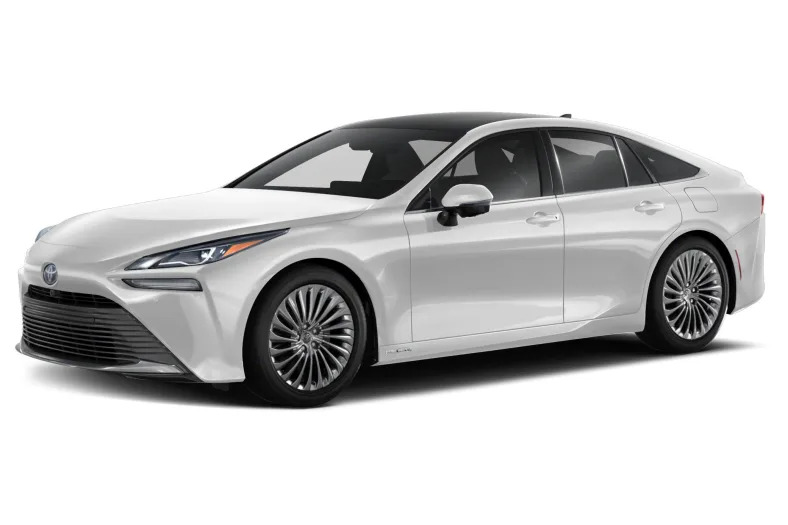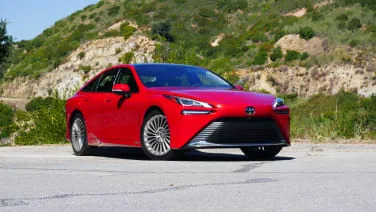XLE 4dr Sedan
2021 Toyota Mirai
It’s an ecological fantasy about as old as the automobile: Drive as much as you want, but spew nothing but pure H2O out the tailpipe. Though hydrogen cars can seem ideal in theory, the first-gen Toyota Mirai faced monumental hurdles when it launched in 2015. Hydrogen's infamously skimpy refueling infrastructure was the biggest, but there was also the four-person cabin, the formidable MSRP of $58,550 and styling that made it look like the spawn of a Prius and Voltron. The mere existence of a 2021 Toyota Mirai therefore defies the odds, but for its second generation, Toyota's underdog eco machine has been re-imagined in virtually every way. The drivetrain migrates from front to rear-drive, enabled by a move to a downsized version of the GA-L platform found the Lexus LS sedan. The lower, wider underpinnings yield a perfect 50/50 weight distribution, improved over the first car’s 58/41 figure. The chassis also lends it a sleeker profile, with the mushed-up front and rear ends becoming replaced with a more Camry-like nose and a far more palatable tail that looks like a budget take on an Audi A7. The Mirai now seats five and a new XLE trim level shaves $9,050 from the MSRP; the Limited trim comes in at $66,000, or $7,450 over the first-gen model. As before, Toyota covers up to $15,000 of hydrogen fill-ups for three years, as well as 21 days of car rentals should you need to venture beyond your hydrogen-fueled bubble. There is also a $4,500 rebate from the state of California and a $8,000 federal tax credit that was recently re-upped as part of the recent economic stimulus bill. Before delving into what makes this Mirai's powertrain new-and-improved, we should probably reacquaint you with the basics of a hydrogen fuel cell car. Rather than a gasoline engine, there's a stack of fuel cells where hydrogen and oxygen are chemically combined to create electricity. Excess energy is stored in a battery pack. Together, the pack and fuel cells power an electric motor and produce nothing but water as a byproduct. With Mirai 101 out of the way, improvements to the fuel cell stack for 2021 include a 50% reduction in weight and, vitally, a 20% reduction in size that allows the stack to be placed under the hood. It was under the front seats in the old car, which resulted in an oddly tall seating position. Output of the now rear-mounted electric motor improves for 2021 with 182 horsepower and 221 pound-feet, up from 151 hp and 247 lb-ft. The battery pack also gets an upgrade, going from nickel metal-hydride to lithium-ion. Eleven pounds of hydrogen are stored in three carbon fiber tanks at 10,000 psi, and require around 5 minutes to refuel. The new Mirai offers a range of 402 miles (with XLE trim), a 30% improvement over the prior model; the Limited model claims 65 MPGe combined, or 74 MPGe for the XLE version. Walk around the new Mirai, and you’ll see exterior …
Full Review
It’s an ecological fantasy about as old as the automobile: Drive as much as you want, but spew nothing but pure H2O out the tailpipe. Though hydrogen cars can seem ideal in theory, the first-gen Toyota Mirai faced monumental hurdles when it launched in 2015. Hydrogen's infamously skimpy refueling infrastructure was the biggest, but there was also the four-person cabin, the formidable MSRP of $58,550 and styling that made it look like the spawn of a Prius and Voltron. The mere existence of a 2021 Toyota Mirai therefore defies the odds, but for its second generation, Toyota's underdog eco machine has been re-imagined in virtually every way. The drivetrain migrates from front to rear-drive, enabled by a move to a downsized version of the GA-L platform found the Lexus LS sedan. The lower, wider underpinnings yield a perfect 50/50 weight distribution, improved over the first car’s 58/41 figure. The chassis also lends it a sleeker profile, with the mushed-up front and rear ends becoming replaced with a more Camry-like nose and a far more palatable tail that looks like a budget take on an Audi A7. The Mirai now seats five and a new XLE trim level shaves $9,050 from the MSRP; the Limited trim comes in at $66,000, or $7,450 over the first-gen model. As before, Toyota covers up to $15,000 of hydrogen fill-ups for three years, as well as 21 days of car rentals should you need to venture beyond your hydrogen-fueled bubble. There is also a $4,500 rebate from the state of California and a $8,000 federal tax credit that was recently re-upped as part of the recent economic stimulus bill. Before delving into what makes this Mirai's powertrain new-and-improved, we should probably reacquaint you with the basics of a hydrogen fuel cell car. Rather than a gasoline engine, there's a stack of fuel cells where hydrogen and oxygen are chemically combined to create electricity. Excess energy is stored in a battery pack. Together, the pack and fuel cells power an electric motor and produce nothing but water as a byproduct. With Mirai 101 out of the way, improvements to the fuel cell stack for 2021 include a 50% reduction in weight and, vitally, a 20% reduction in size that allows the stack to be placed under the hood. It was under the front seats in the old car, which resulted in an oddly tall seating position. Output of the now rear-mounted electric motor improves for 2021 with 182 horsepower and 221 pound-feet, up from 151 hp and 247 lb-ft. The battery pack also gets an upgrade, going from nickel metal-hydride to lithium-ion. Eleven pounds of hydrogen are stored in three carbon fiber tanks at 10,000 psi, and require around 5 minutes to refuel. The new Mirai offers a range of 402 miles (with XLE trim), a 30% improvement over the prior model; the Limited model claims 65 MPGe combined, or 74 MPGe for the XLE version. Walk around the new Mirai, and you’ll see exterior …
Hide Full Review
Hide Full Review
Retail Price
$49,500
MSRP / Window Sticker Price
| Engine | |
| MPG | 76 City / 71 Hwy |
| Seating | 5 Passengers |
| Transmission | 1-spd auto |
| Power | 182 @ rpm |
| Drivetrain | rear-wheel |
Smart Buy Program is powered by 





